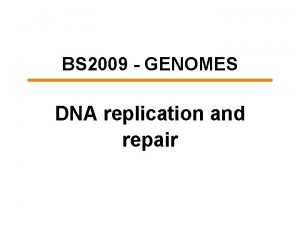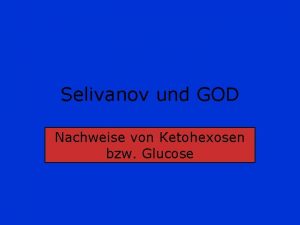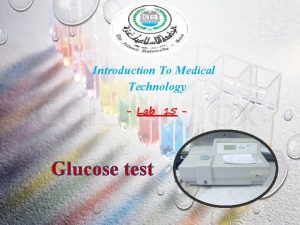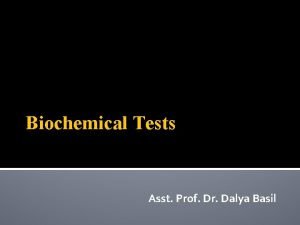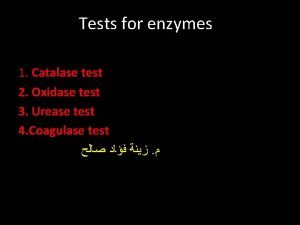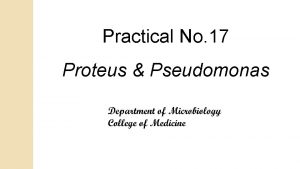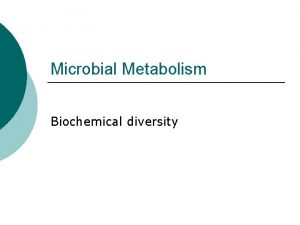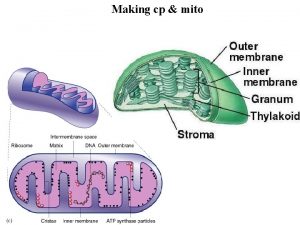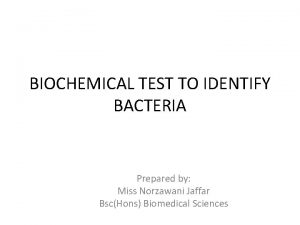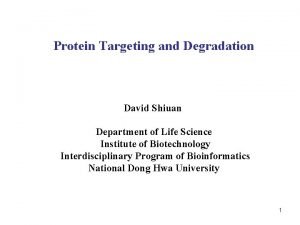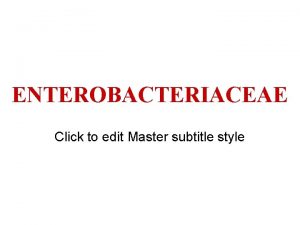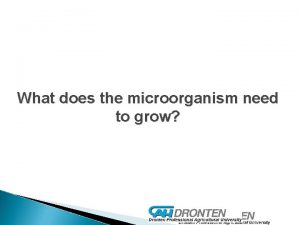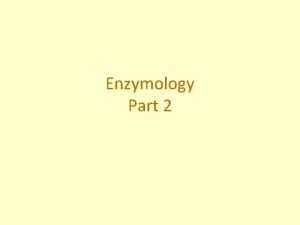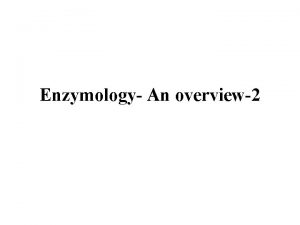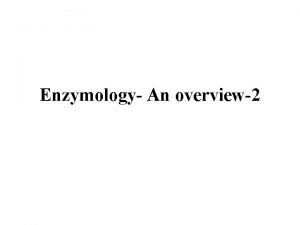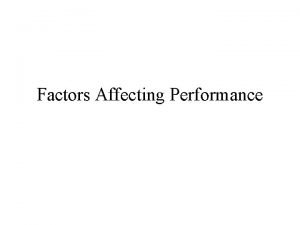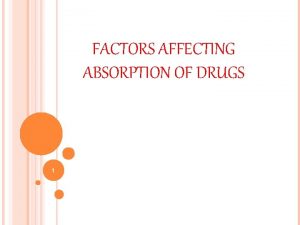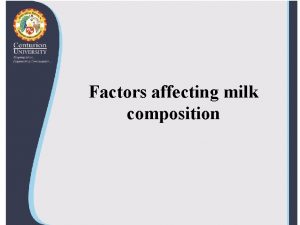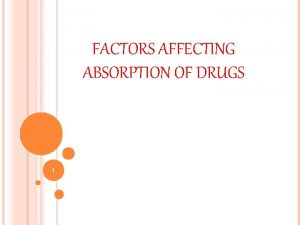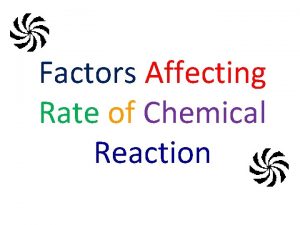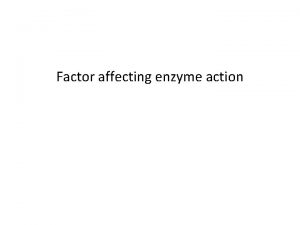Introduction to Enzymology Some factors Affecting polyphenol Oxidase























- Slides: 23

Introduction to Enzymology -Some factors Affecting polyphenol Oxidase Activity

Important notes: • There are 3 terms for an enzymatic reaction to happen: 1. Presence of enzyme 2. Presence of substrate 3. Availability of appropriate conditions ( 37 C, p. H 6. 7) Enzyme If any of these terms are absent there will be no enzymatic reaction. Optimal p. H and Temperature

How can substrate bind to the Enzyme? 1 - The Key and lock hypothesis • Both the enzyme and the substrate possess specific complementary geometric shapes that fit exactly into one another 2 - Induced fit model • The substrate does not simply bind to a rigid active site; the amino acid side chains which make up the active site are molded into the precise positions that enable the enzyme to perform its catalytic function.

How can enzyme increase the rate of a biochemical reactions? 1. Lowering the activation energy 2. Reducing the chance in the collisions of molecules or ions Activation energy : Is the energy that must be overcome in order for a chemical reaction to occur/the minimum energy required to start a chemical reaction , given in units of kilojoules/mole.

• To detect and follow the progress of the reaction in this experiment a simple, qualitative method will be used. • More sophisticated, quantitative methods of following enzyme catalyzed reactions will be introduced later in the course. • In This Lab Polyphenol Oxidase will be studied as an example to understand factors that could affect enzymes Because hundreds of reactions are simultaneously carried out in the living cell, it becomes difficult to study a single reaction in an intact living cell. However, it is possible to extract enzymes from cells and thus study enzyme catalyzed reactions in a test tube. In this experiment, a crude extract of the enzyme polyphenol oxidase will be prepared from the potato.

Objectives: polyphenol oxidase in crude extract prepared from potato. The effect of time Chemical nature of this enzyme Substrate Sepecifity The effect of temperature • In this experiment you will notice the change qualitatively (change in the color only)

Polyphenol Oxidase: • Polyphenol oxidase (PPO): • Copper-containing enzyme with an optimum p. H of 6. 7. It mainly catalyses the oxidation of dihydroxy-and tri hyroxy phenol to the corresponding quinine. • This oxidation-reduction reaction is accompanied by a color change • This reaction commonly occurs in nature and accounts for the "browning" of peeled potatoes and bruised fruits. • You will familiarize yourself with the reaction catalyzed by the enzyme polyphenol oxidase, as it occurs removed from the intact living cell, i. e. in a test tube. Enzymatic Browning O 2 +

1 -Time course Principle: study of • enzymatic • Activity: In this reaction we are looking for enzyme substrate reaction in general In this experiment you will notice the change qualitatively (change in the color). • The intensity of this color (brown) will be proportional to the enzyme’s activity in the tube under observation. • You must notice the color change with the time. . S+E ES enzyme-substrate complex P+E

1. Time course study of enzymatic Activity: a. Label three clean test tubes A, B and C. b. Prepare each tube as follows: Tube Addition TUBE A • 15 drops of enzyme extract. • 15 drops of 0. 01 M catechol solution TUBE B • 15 drops of enzyme extract. • 15 drops of distilled water. TUBE C • 15 drops of 0. 0 M catechol solution. • 15 drops of distilled water c. Place all three tubes in a water bath at 37 ºC. d. Shake each tube every 5 minutes to aerate, thereby adding oxygen to the solution. e. Every 5 minutes, after shaking, hold the tubes up to the light and examine.

Results: 1 -Enzymic activity: Record the color in each tube, according to the scheme described in this page, in the table in the "Results" section. Continue for 25 minutes. Incubation time (minutes) 0 5 10 15 20 25 Degree of color intensity (Symbol: −, +, ++ or +++) TUBE A TUBE B TUBE C

2 -CHEMICAL NATURE OF POLYPHENOL OXIDASE: • Majority of enzymes are proteins. Some are made of RNA • The nature of polyphenol oxidase will be examined wither is it protein or not Protein (Enzyme) RNA(catalytic)

2. Chemical nature of polyphenol oxidase: a. Label four clean test tubes A, B, C and D. b. Prepare, and teat, each tube as follows: Tube (1) (2) (3) TUBE A • 15 drops of enzyme extract. • 15 drops of 0. 01 M catechol solution • Shake tube and place in water bath at 37 ºC for 10 minutes. • As a Control! TUBE B • 10 drops of enzyme extract. • 10 drops of 5% trypsin solution. Shake tube thoroughly. Add 10 drops of 0. 01 M catechol Place tube in a water bath at 37 solution. Place in water bath at ºC for 10 minutes. 37 ºC for 10 minutes

TUBE C • Add 10 drops of enzyme extract. • Add 10 drops of 5% trichloroacetic acid. • Shake tube thoroughly and wait 5 minutes. Add 10 drops of 0. 01 M catechol solution. Place in water bath at 37 ºC for 10 minutes TUBE D Add 15 drops of enzyme extract. Add a few crystals of phenylthiourea Shake tube thoroughly and continue shaking it frequently during a period of 5 minutes. Then add 15 drops of 0. 01 M catechol solution. Place in water bath at 37 ºC for 10 minutes • Examine and compare with tube A. • Record your observations in the table in the "Results" section.

Results: 2 -Chemical nature of polyphenol oxidase Tube Treatment A Control B Trypsin C D TCA Phenylthiourea Degree of color intensity (Symbol: −, +, ++ or +++) • Trypsin: a proteolytic enzyme • TCA: an acid( low p. H) that precipitate and denature proteins • Phenylthiourea: Phenylthiourea has a very strong chemical affinity for the element copper.

3 - Substrate specificity: • The substrate binds to the enzyme at the active site. Since enzymes are proteins, this site is composed of a unique combination of amino acid residues (side chains or R groups). Which play a role in the specifity of the enzyme toward substrate

Types of Enzyme Specificity • There are four distinct types of specificity: ü Absolute specificity - the enzyme will catalyze only one reaction. ü Group specificity - the enzyme will act only on molecules that have specific functional groups, such as amino, phosphate and methyl groups. ü Linkage specificity - the enzyme will act on a particular type of chemical bond regardless of the rest of the molecular structure. ü Stereochemical specificity - the enzyme will act on a particular steric or optical isomer.

3 -Substrate specificity: • The three compounds used as substrates in this part of the experiment are structurally related (mono-and di-hydroxyl phenol)

3 -Substrate specificity: a. Label three clean test tubes A, B and C. Tube (1) (2) TUBE A • 15 drops of enzyme extract. • Add 15 drops of 0. 01 M catechol solution TUBE B • 15 drops of enzyme extract. • • Add 15 drops of 0. 01 M phenol solution TUBE C • 15 drops of enzyme extract. • 15 drops of 0. 01 M hydroquinone b. Shake the tubes gently and place them in a water bath at 37 ºC. c. Examine the tubes after 5 minutes and after 10 minutes. Record the color in each tube, in the table in the "Results" section. d. The three compounds used as substrates in this part of the experiment are structurally related, as shown in the figure below. Each is capable of reacting with oxygen to form various colored products.

• Results: • Substrate specificity: Substrate Catechol Phenol Hydroquinone Degree of color intensity (Symbol: −, +, ++ or +++) 5 minutes 10 minutes

4 -Temperature and enzymatic activity: Optimum Tm: is that Tm at which the activity of the enzyme is maximum

4 -Temperature and enzymatic activtiy: a. Label three clean test tubes A, B and C. Tube (1) (2) Incubate At: (3) TUBE A • Add 15 drops of enzyme 0 ºC extract to each tube. Add 15 drops of 0. 01 M catechol solution to each tube. TUBE B • Add 15 drops of enzyme 37 ºC. extract to each tube. Add 15 drops of 0. 01 M catechol solution to each tube. TUBE C • Add 15 drops of enzyme 70 ºC. extract to each tube. Add 15 drops of 0. 01 M catechol solution to each tube. b. Shake each tube gently and quickly return it to its proper temperature condition. c. Wait for 15 minutes. After this time, examine each tube, without removing it from its temperature condition, and record the color in each tube, according to the scheme described on page 3, in the table in the "Results" section.

4 -Temperature and enzymatic activity Temperature (ºC) 0 37 70 Degree of color intensity (Symbol: −, +, ++ or +++)

Discussion • Discuss in each experiment what you observing and the reasons behind the findings
 Polyphenol rich foods
Polyphenol rich foods Enzymology of replication
Enzymology of replication Principle of glucose estimation by glucose oxidase method
Principle of glucose estimation by glucose oxidase method Emb aga
Emb aga Glucose-oxidase-test reaktionsgleichung
Glucose-oxidase-test reaktionsgleichung Test lab 15
Test lab 15 Enterobacteriaceae classification
Enterobacteriaceae classification Catalase test procedure
Catalase test procedure Moraxella catarrhalis oxidase
Moraxella catarrhalis oxidase Urease test purpose
Urease test purpose Kligler iron agar results
Kligler iron agar results Catechol oxidase and potato extract lab report
Catechol oxidase and potato extract lab report Positive for catalase
Positive for catalase Glycolytic pathways
Glycolytic pathways Alternative oxidase in plants
Alternative oxidase in plants Oxidase test
Oxidase test Mycobacterium oxidase test
Mycobacterium oxidase test Oxidase test
Oxidase test Mannose oxidase
Mannose oxidase Altering drug metabolism
Altering drug metabolism Oxidase positive bacteria
Oxidase positive bacteria Ocean currents
Ocean currents Factors affecting microbial growth in food
Factors affecting microbial growth in food Factors affecting volcanic eruption
Factors affecting volcanic eruption

